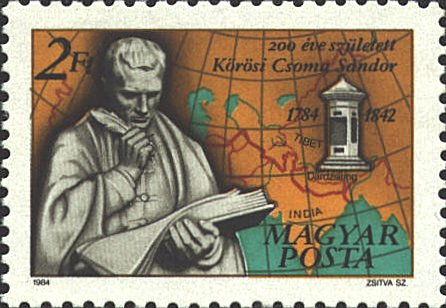|
As a young man Sándor Csoma Korösis' great
ambition was to find the ancient homeland of the Hungarian people. He
never achieved this goal. However, he would still become world famous
for introducing the language and culture of Tibet to Europe.
He was born on in the Korös community of Transylvania.
He began his studies at the Nagyenyed College and was sent to
Göttingen in 1815. There he studied Asian languages. In November of
1819 his travels began. He arrived in Teheran in 1820. He studied
there for 4 months. He then joined a caravan thru Afganiztan bound for
India.
In 1822, he arrived in northwest India at the
headquarters of the Lakakhi Kingdom. However, from here, because of
the risky and volatile atmosphere, he was unable to continue his
pilgrimage to East-Turkistan where he believed he would find the
homeland of his ancestors. He met with an English official who
convinced him to study the Tibetan language. He accepted this
challenge hoping that in the Tibetan Llamas libraries he would find
the origins of the Asian people who were the ancestors of the
Hungarians.
From 1822 to 1830, Korösis, while living in different
monasteries, learned the Tibetan language, history, and literature as
well as Buddhism. In 1831, he went back to Calcutta, where he worked
in the Asian Society Library for 2 years. During that time he prepared
his fundamental work. The Tibetan Grammar and Tibetan-English
Dictionary were issued in 1834. In 1842 Korösi again traversed Tibet
in a northern direction hoping to find the ancient homeland of the
Hungarians. He did not get very far. He contracted malaria, then
incurable, and died in the Himalayas near Darjeeling. His tomb with
inscriptions in both English and Hungarian can still be seen.
The stamp was issued in 1984, the 200th anniversary of Korösi’s birth.
It shows a map of the Indian sub-continent and Korösi’s route.

 |
